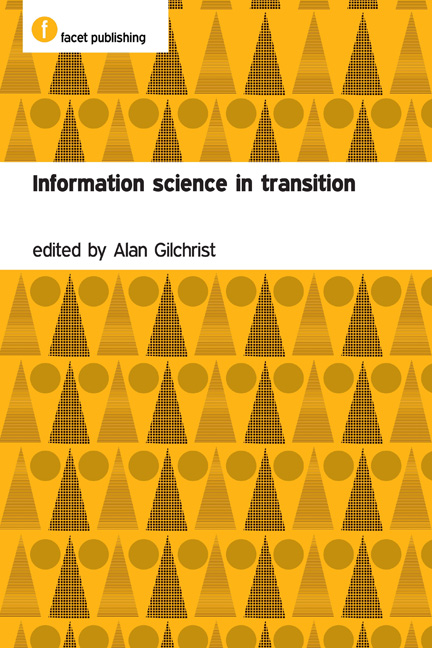Book contents
- Frontmatter
- Contents
- Contributors
- Preface
- Editorial
- Guest Editorial: Meeting the challenge
- 1 Fifty years of UK research in information science
- 2 Smoother pebbles and the shoulders of giants: the developing foundations of information science
- 3 The last 50 years of knowledge organization: a journey through my personal archives
- 4 On the history of evaluation in IR
- 5 The information user: past, present and future
- 6 The sociological turn in information science
- 7 From chemical documentation to chemoinformatics: 50 years of chemical information science
- 8 Health informatics: current issues and challenges
- 9 Social informatics and sociotechnical research – a view from the UK
- 10 The evolution of visual information retrieval
- 11 Information policies: yesterday, today, tomorrow
- 12 The disparity in professional qualifications and progress in information handling: a European perspective
- 13 Electronic scholarly publishing and Open Access
- 14 Social software: fun and games, or business tools?
- 15 Bibliometrics to webometrics
- 16 How I learned to love the Brits
- Index
7 - From chemical documentation to chemoinformatics: 50 years of chemical information science
Published online by Cambridge University Press: 08 June 2018
- Frontmatter
- Contents
- Contributors
- Preface
- Editorial
- Guest Editorial: Meeting the challenge
- 1 Fifty years of UK research in information science
- 2 Smoother pebbles and the shoulders of giants: the developing foundations of information science
- 3 The last 50 years of knowledge organization: a journey through my personal archives
- 4 On the history of evaluation in IR
- 5 The information user: past, present and future
- 6 The sociological turn in information science
- 7 From chemical documentation to chemoinformatics: 50 years of chemical information science
- 8 Health informatics: current issues and challenges
- 9 Social informatics and sociotechnical research – a view from the UK
- 10 The evolution of visual information retrieval
- 11 Information policies: yesterday, today, tomorrow
- 12 The disparity in professional qualifications and progress in information handling: a European perspective
- 13 Electronic scholarly publishing and Open Access
- 14 Social software: fun and games, or business tools?
- 15 Bibliometrics to webometrics
- 16 How I learned to love the Brits
- Index
Summary
Abstract
This paper summarizes the historical development of the discipline that is now called ‘chemoinformatics’. It shows how this has evolved, principally as a result of technological developments in chemistry and biology during the past decade, from long-established techniques for the modelling and searching of chemical molecules. A total of 30 papers, the earliest dating back to 1957, are briefly summarized to highlight some of the key publications and to show the development of the discipline.
Introduction
Chemistry is, and has been for many years, one of the most information-rich academic disciplines. The very first journal devoted to chemistry was Chemisches Journal, which was published 1778–84 and then, under the name of Chemische Annalen, till 1803 [1]. The growth in the chemical literature during the nineteenth century led to a recognition of the need for comprehensive abstracting and indexing services for the chemical sciences. The principal such service is Chemical Abstracts Service (CAS), which was established in 1907 and which acts as the central repository for the world's published chemical (and, increasingly, life-sciences) information. The size of this repository is impressive: at the end of its first year of operations, the CAS database contained ca 12,000 abstracts; by the end of 2006, this had grown to ca 25 million abstracts with ca 1 million being added each year. Most chemical publications will refer to one or more chemical substances. The structures of these substances form a vitally important part of the chemical literature, and one that distinguishes chemistry from many other disciplines. The CAS Registry System was started in 1965 to provide access to substance information, initially registering just small organic and inorganic molecules but now also registering biological sequences [2]. At the end of 1965 there were ca 222,000 substances in the System; by the end of 2006 this had grown to ca 89 million substances, of which ca one-third were small molecules and the remainder biological sequences, with ca 1.5 million being added each year. There are also many additional molecular structures in public databases such as the Beilstein Database [3], and corporate files, in particular those of the major pharmaceutical, agrochemical and biotechnology companies.
- Type
- Chapter
- Information
- Information Science in Transition , pp. 129 - 168Publisher: FacetPrint publication year: 2009



